Springfield, Massachusetts Blood Testing Facilities
 Represents a LabCorp blood testing facility
Represents a LabCorp blood testing facility Represents a Quest Diagnostics blood testing facility
Represents a Quest Diagnostics blood testing facility

Nearby Labcorp Blood Testing facilities:
- Labcorp Center Distance: 29 m, 2284 Berlin Turnpike, Newington, Hartford County, CT, 6111
- Labcorp Center Distance: 37 m, 72 Cudworth Rd, Webster, Worcester County, MA, 1570
- Labcorp Center Distance: 42 m, 21 Eastern Avenue Suite G2, Worcester, Worcester County, MA, 1605
- Labcorp Center Distance: 44 m, 1068 W Main St, Waterbury, New Haven County, CT, 6708
- Labcorp Center Distance: 45 m, 12 Case St Ste 302, Norwich, New London County, CT, 6360
- Labcorp Center Distance: 52 m, 3018 Dixwell Ave 3Rd Fl, Hamden, New Haven County, CT, 6518
- Labcorp Center Distance: 59 m, 1301 River St Rm 103, Valatie, Columbia County, NY, 12184
- Labcorp Center Distance: 60 m, 755 Campbell Ave Ste 3, West Haven, New Haven County, CT, 6516
- Labcorp Center Distance: 64 m, 2500 Pondview Suite 102, Castleton On Hudson, Rensselaer County, NY, 12033
- Labcorp Center Distance: 66 m, 146 Jefferson Heights, Catskill, Greene County, NY, 12414
- Labcorp Center Distance: 68 m, 4750 Main St, Bridgeport, Fairfield County, CT, 6606
- Labcorp Center Distance: 69 m, 16 W Bridge St, Saugerties, Ulster County, NY, 12477
- Labcorp Center Distance: 70 m, 2001 5Th Avenue, Troy, Rensselaer County, NY, 12180
- Labcorp Center Distance: 71 m, 6 Lexington St 2Nd Floor, Waltham, Middlesex County, MA, 2452
- Labcorp Center Distance: 72 m, 1400 Centre St Ste 208 2Nd Fl, Newton Center, Middlesex County, MA, 2459
- Labcorp Center Distance: 73 m, 368 Broadway Ste 303, Kingston, Ulster County, NY, 12401
- Labcorp Center Distance: 74 m, 330 Washington Avenue, Kingston, Ulster County, NY, 12401
- Labcorp Center Distance: 76 m, 222 State Route 299, Highland, Ulster County, NY, 12528
- Labcorp Center Distance: 77 m, 966 Park St Unit B7, Stoughton, Norfolk County, MA, 2072
- Labcorp Center Distance: 78 m, 200 Westage Business Ctr Ste 133, Fishkill, Dutchess County, NY, 12524
- Labcorp Center Distance: 79 m, 279 Main St Ste 200, New Paltz, Ulster County, NY, 12561
- Labcorp Center Distance: 81 m, 45 Route 25A Ste E2, Shoreham, Suffolk County, NY, 11786
- Labcorp Center Distance: 82 m, 25 Pelham Rd Ste 103A, Salem, Rockingham County, NH, 3079
- Labcorp Center Distance: 83 m, 1336 Union St, Schenectady, Schenectady County, NY, 12308
- Labcorp Center Distance: 84 m, 46 Route 25A Suite 2, Setauket, Suffolk County, NY, 11733
- Labcorp Center Distance: 85 m, 200 Sutton St Ste 135, North Andover, Essex County, MA, 1845
- Labcorp Center Distance: 86 m, 380 Merrimack St Ste B2, Methuen, Essex County, MA, 1844
- Labcorp Center Distance: 87 m, 1985 Crompond Rd Bldg B, Cortlandt Manor, Westchester County, NY, 10567
- Labcorp Center Distance: 88 m, 2500 Nesconset Hwy Ste 30-31, Stony Brook, Suffolk County, NY, 11790
- Labcorp Center Distance: 90 m, 617 A Montauk Hwy, Center Moriches, Suffolk County, NY, 11934
- Labcorp Center Distance: 91 m, 2 Brooksite Dr, Smithtown, Suffolk County, NY, 11787
- Labcorp Center Distance: 93 m, 285 Sills Rd Bldg 11D, East Patchogue, Suffolk County, NY, 11772
- Labcorp Center Distance: 94 m, 1770 Motor Pkwy 2Nd Fl, Hauppauge, Suffolk County, NY, 11788
- Labcorp Center Distance: 95 m, 775 Park Ave Ste 350, Huntington, Suffolk County, NY, 11743
- Labcorp Center Distance: 96 m, 297 Knollwood Rd Ste 102, White Plains, Westchester County, NY, 10607
- Labcorp Center Distance: 97 m, 311 North Midland Ave, Nyack, Rockland County, NY, 10960
- Labcorp Center Distance: 98 m, 33 Park St 1St Floor, Glens Falls, Warren County, NY, 12801
- Labcorp Center Distance: 99 m, 150 Islip Ave Ste 9, Islip, Suffolk County, NY, 11751
Nearby Quest Blood Testing facilities:
- Quest Center Distance: 8 m, 100 Hazard Ave, Enfield, Hartford County, CT, 06082-5447
- Quest Center Distance: 13 m, 2 Concorde Way, Building 3A, Windsor Locks, Hartford County, CT, 06096-1577
- Quest Center Distance: 19 m, 520 Hartford Turnpike, Vernon, Tolland County, CT, 06066-0000
- Quest Center Distance: 20 m, 381 Hopmeadow Street, Simsbury, Hartford County, CT, 06089-9692
- Quest Center Distance: 23 m, 555 Main Street, Manchester, Hartford County, CT, 06040-5196
- Quest Center Distance: 24 m, 100 Retreat Ave, Hartford, Hartford County, CT, 06106-2528
- Quest Center Distance: 27 m, 465 Silas Deane Highway, Wethersfield, Hartford County, CT, 06109-2134
- Quest Center Distance: 28 m, 45 S Main St, Unionville, Hartford County, CT, 06085-1278
- Quest Center Distance: 31 m, 1933 E Main St, Torrington, Litchfield County, CT, 06790-3102
- Quest Center Distance: 32 m, 135D Storrs Rd, Mansfield Center, Tolland County, CT, 06250-1638
- Quest Center Distance: 36 m, 365 Queen Street, Southington, Hartford County, CT, 06489-0000
- Quest Center Distance: 38 m, 400 Saybrook Rd, Middletown, Middlesex County, CT, 06457-4731
- Quest Center Distance: 40 m, 816 Broad Street, Ste 22, Meriden, New Haven County, CT, 06450-4364
- Quest Center Distance: 41 m, 42 Summer St, Pittsfield, Berkshire County, MA, 01201-4526
- Quest Center Distance: 42 m, 100 Mlk, Jr. Blvd, Worcester, Worcester County, MA, 01608-1220
- Quest Center Distance: 44 m, 60 Westwood Avenue, Waterbury, New Haven County, CT, 06708-2460
- Quest Center Distance: 46 m, 55 Town Street, Norwich, New London County, CT, 06360-2332
- Quest Center Distance: 52 m, 79 Erdman Way, Leominster, Worcester County, MA, 01453-0000
- Quest Center Distance: 54 m, 15 Chesterfield Road, East Lyme, New London County, CT, 06333-1730
- Quest Center Distance: 56 m, 11 Woodland Road, Madison, New Haven County, CT, 06443-2342
- Quest Center Distance: 57 m, 721 Bank Street, New London, New London County, CT, 06320-5005
- Quest Center Distance: 58 m, 60 Temple Street, New Haven, New Haven County, CT, 06510-2716
- Quest Center Distance: 59 m, 391 West Street, Keene, Cheshire County, NH, 03431-0000
- Quest Center Distance: 61 m, 61 Lincoln St, Framingham, Middlesex County, MA, 01702-8264
- Quest Center Distance: 62 m, 515 Bridgeport Ave, Shelton, Fairfield County, CT, 06484-5366
- Quest Center Distance: 63 m, 1 Randall Sq, Providence, Providence County, RI, 02904-2709
- Quest Center Distance: 64 m, 7 Germantown Rd, Danbury, Fairfield County, CT, 06810-5000
- Quest Center Distance: 69 m, 10 Commercial St, Foxboro, Norfolk County, MA, 02035-2509
- Quest Center Distance: 70 m, 330 Route 212, Saugerties, Ulster County, NY, 12477-5122
- Quest Center Distance: 71 m, 335 Morse St, 1St Floor, Norwood, Norfolk County, MA, 02062-5034
- Quest Center Distance: 72 m, 695 Dutchess Tpke, Poughkeepsie, Dutchess County, NY, 12603-6442
- Quest Center Distance: 73 m, 300 Main St, Nashua, Hillsborough County, NH, 03060-4635
- Quest Center Distance: 74 m, 380 Washington Ave, Kingston, Ulster County, NY, 12401-3702
- Quest Center Distance: 75 m, 2 Executive Park Dr, Albany, Albany County, NY, 12203-3700
- Quest Center Distance: 76 m, 700 Rogers Street, Lowell, Middlesex County, MA, 01854-3571
- Quest Center Distance: 77 m, 319 Longwood Ave, Boston, Suffolk County, MA, 02115-5728
- Quest Center Distance: 78 m, 982 Main St, Fishkill, Dutchess County, NY, 12524-3506
- Quest Center Distance: 79 m, 340 Wood Rd, Suite 302, Braintree, Norfolk County, MA, 02184-2410
- Quest Center Distance: 80 m, 246 Main St, New Paltz, Ulster County, NY, 12561-1608
- Quest Center Distance: 81 m, 6144 Route 25A, Wading River, Suffolk County, NY, 11792-2018
- Quest Center Distance: 82 m, 1478 State St, Schenectady, Schenectady County, NY, 12304-2917
- Quest Center Distance: 83 m, 851 Main Street, S. Weymouth, Norfolk County, MA, 02190-2409
- Quest Center Distance: 84 m, 1010 Route 112, Port Jefferson Station, Other, NY, 11776-2054
- Quest Center Distance: 85 m, 83 South Bedford Rd, Mt. Kisco, Westchester County, NY, 10549-3457
- Quest Center Distance: 87 m, 1869A E Main St, Peekskill, Westchester County, NY, 10566-2505
- Quest Center Distance: 88 m, 237 State Rd, North Dartmouth, Bristol County, MA, 02747-2612
- Quest Center Distance: 89 m, 180-182 Endicott Street, Danvers, Essex County, MA, 01923-0000
- Quest Center Distance: 90 m, 570 Expressway Dr South, Medford, Other, NY, 11763-2049
- Quest Center Distance: 91 m, 222 Middle Country Rd, Smithtown, Suffolk County, NY, 11787-2814
- Quest Center Distance: 93 m, 285 Sills Rd, East Patchogue, Suffolk County, NY, 11772-4869
- Quest Center Distance: 94 m, 175 E Main St, Huntington, Suffolk County, NY, 11743-2912
Massachusetts Hormone Replacement Therapy Solutions
The Conscious Evolution Institute is Massachusetts' best source for twenty-first century Hormone Optimization and Restoration. We serve every corner of Massachusetts, and we can even meet you at your home or business in order to perform the evaluation necessary to make an informed diagnosis on your behalf.
With our assistance, we can help you mitigate or overcome the pitfalls of hormone imbalance, improving your health and wellness and increasing the odds that you live a longer and happier life.
Massachusetts HGH Therapy
One of the premier services that we offer at the Conscious Evolution Institute is Bio-Identical Human Growth Hormone Replacement Therapy. HGH is one of the most important and vital hormones that the body produces when it comes to maintaining optimal health and function.
Growth Hormone controls cellular metabolism, enhancing the efficiency of cellular processes throughout the body. As we grow older, our HGH Levels decline and our bodies slowly lose the capacity to sustain the rehabilitative processes which keep us functioning at peak capacity, which leads to symptoms of premature aging and a litany of symptoms that diminish our physical and psychological well-being.
HGH Injections are designed to restore HGH concentrations to more youthful levels, keeping the body functioning more efficiently, and these services are available to men and women over the age of thirty with clinically diagnosed HGH Deficiency.
Massachusetts Sermorelin Injections
If you're interested in what HGH Injections can do for you, but want to maximize the value of your dollar, Sermorelin Acetate Therapy is a slightly cheaper form of therapy which provides similar benefits as Human Growth Hormone Replacement Therapy. Recombinant Sermorelin Therapy restores HGH Levels in the body by supplementing the production of Growth Hormone-Releasing Hormone by the Hypothalamus. Give us a call and ask us about which form of treatment may be best for you!
Massachusetts Testosterone Replacement Therapy
Erectile Dysfunction can be one of the most embarrassing medical conditions that a man has to deal with, but did you know that ED can actually be a symptom of more severe, underlying health issues? Low-T not only impacts sexual health, but it can severely diminish your health and vitality as well.
Symptoms of Age-Related Testosterone Deficiency include increased weight gain, loss of muscle mass, anxiety, and atherosclerosis, and if you allow these symptoms to persist, you could be shaving years off your own life. Bio-Identical Testosterone HRT can restore optimal Testosterone Levels and help enhance your health and quality of life.
Massachusetts HCG Injections for Weight Loss
The Conscious Evolution Institute also offers weight loss solutions, most notably the HCG Diet. The HCG Diet is a combination of Recombinant Hormone Injections and Caloric Restriction which has been clinically shown to rapidly encourage weight loss while softening the side-effects of dieting which make diets so often fail.
With HCG Diets, you can lose 5-7 pounds per week without experiencing any significant road bumps along the way. HCG reduces sensations of hunger and optimizes fat burning, helping you burn calories from the most troublesome areas of the body. With a simple call to our clinic, we can help melt the pounds away!
Major Cities in Massachusetts
Boston
Boston, Massachusetts is the largest city in the state of Massachusetts, as well as the largest city in all of New England. Boston is famous for being one of the most highly educated major cities in the United States, and is home to a large number of Universities, including Northeastern University, Boston University, and Boston College.
Boston has a number of prestigious professional sports teams, including the Boston Red Socks, the Boston Celtics, and the New England Patriots. The most famous athletic event held annually in Boston is the Boston Marathon, where thousands from all over the world run each and every year.
Worchester
Worchester, Massachusetts is located in the central portion of the state, in Worchester County, and is the second largest city in the state. One interesting piece of trivia about the city is that it has a number of Victorian mills. Worchester is often referred to by the nickname, The Heart of the Commonwealth. The symbol of the city is a heart.
Worchester has one of the best medical schools in the United States, The University of Massachusetts Medical School. The largest employer in the city is UMass Memorial Health Care, followed by the medical school, itself.
Springfield
Springfield is located in the southwestern portion of the state of Massachusetts, and is the third largest city by population, and the second largest metropolitan area. Springfield is one of New England's oldest cities, founded in 1636.
The city is often referred to as The City of Homes because of its numerous examples of Victorian Homes. Springfield is also known as the Hoop City, because it was the city where the sport of basketball was invented. The city is located in the heart of the Knowledge Corridor, a region with the highest concentration of liberal arts colleges in the United States.
Lowell
Lowell, Massachusetts is located in the northeastern corner of Massachusetts and is the fourth most populated city in the state. Lowell was first settled in 1653, and was historically one of the most important industrial cities in New England. Lowell is located along the meeting point of the Concord and Merrimack Rivers. Because of its historical importance as an industry town, Lowell has a number of protected landmarks, including the American Textile History Museum, the Boott Cotton Mills Museum, and the New England Quilt Museum.
Cambridge
Cambridge is the fifth most highly populated city in the state of Massachusetts, but arguably the most iconic city in the state after Boston. Cambridge is home to two of the most prestigious schools in the United States, as well as the world: The Massachusetts Institute of Technology and Harvard University.
The Cambridge economy revolves primarily around education and fields that feed off of the presence of education. There are a number of biomedical and pharmaceutical companies in the area, including Pfizer, Genzyme, and Vertex Pharmaceuticals.
All About Springfield, Massachusetts Geographic Area


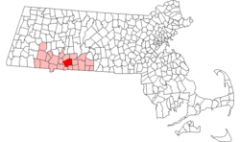
Springfield is the most populous city in Western New England, and the seat of Hampden County, Massachusetts, United States. Springfield sits on the eastern bank of the Connecticut River near its confluence with three rivers; the western Westfield River, the eastern Chicopee River, and the eastern Mill River. As of the 2010 Census, the city's population was 153,060. Metropolitan Springfield ae one of two metropolitan areas in Massachusetts (the other being Greater Boston) ae has an estimated population of 698,903, as of 2009.
The first Springfield in the New World, it is the largest city in Western New England, and the urban, economic, and cultural capital of Massachusetts' Connecticut River Valley, (colloquially known as the Pioneer Valley). It is the third-largest city in Massachusetts and fourth-largest in New England (Boston, Worcester, and Providence are larger). Springfield has several nicknames ae The City of Firsts, because of its many innovations (see below for a partial list); The City of Homes, due to its Victorian residential architecture; and Hoop City, because basketball, one of the worlds most popular sports, was invented in Springfield.
Hartford, the State of Connecticut's capital city, lies only 23.9 miles (38.5 km) south of Springfield, on the western bank of the Connecticut River. Springfield residents use Bradley International Airport (owned and operated by the Connecticut Department of Transportation). Also known as the Hartford-Springfield airport, it lies equidistant between them. The Hartford-Springfield region is known as the Knowledge Corridor because it hosts over 160,000 university students and over 32 universities and liberal arts colleges ae the second-highest concentration of higher-learning institutions in the United States. The City of Springfield itself is home to Springfield College; Western New England University; American International College; the University of Massachusetts Amherst's School of Urban Design; and Springfield Technical Community College, among other higher educational institutions.
Founded by the English colonist William Pynchon, in 1640 the city was named after his hometown of Springfield, Essex in England. The city of Springfield has played an important role throughout American history, due largely to its geography. Founded on some of New England's most fertile soil, it is located midway between Boston and Albany; it is only slightly farther from New York City, and is the closest major New England city to Montreal. In 1777, Springfield's location led George Washington and Henry Knox to found the fledgling United States' National Armory at Springfield, which produced the first American musket in 1794, and later the famous Springfield rifle. From 1777 until its closing during the Vietnam War, the Springfield Armory attracted skilled laborers to Springfield, making it the United States' longtime epicenter for precision manufacturing. Springfielders produced many of America's most significant innovations, including the first American-English dictionary (1805, Merriam Webster); the first use of interchangeable parts and the assembly line in manufacturing, (1819, Thomas Blanchard;) the first American horseless car, (1825, Thomas Blanchard;) the discovery and patent of vulcanized rubber, (1844, Charles Goodyear;) the first American gasoline-powered car, (1893, Duryea Brothers); the first successful motorcycle company, (1901, "Indian"); one of America's first commercial radio stations, (1921, WBZ from the Hotel Kimball); and most famous for the world's second-most-popular sport, basketball, (1891, Dr. James Naismith).
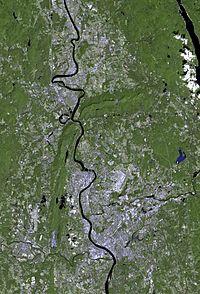
Springfield is located at 42 °6 a²45 a³N 72 °32 a²51 a³W / 42.1125 °N 72.5475 °W / 42.1125; -72.5475 (42.112411, na72.547455). According to the United States Census Bureau, the city has a total area of 33.2 square miles (86 km2) of which 32.1 square miles (83 km2) is land and 1.1 square miles (2.8 km2) (3.31%) is water. Over 4 sq. mi of Springfield's land area is parkland, (over 12% of its total land area.)
Springfield sits on the eastern bank of the Connecticut River, near confluence of two major tributary rivers: the western Westfield River, which flows into the Connecticut across from Springfield's South End Bridge; and the eastern Chicopee River, which flows into the Connecticut les than 0.5miles north of Springfield, in the bordering city of Chicopee. Springfield lies just 4 miles (6.4 km) north of the Connecticut state-line. It is located in the fertile Connecticut River Valley, surrounded by mountains, bluffs, and rolling hills in all directions. Springfield's Metro Center and Main Street, which follow the north-south trajectory of the Connecticut River, are fairly low and flat; however, they become hilly and feature prominent bluffs as one moves south and eastward.
Springfield's 2nd most prominent topographical feature is the city's 735 acres (2.97 km2) Forest Park, designed by renowned landscape architect Frederick Law Olmsted. Forest Park lies in the southwestern corner of the city, surrounded by Springfield's attractive garden districts Forest Park and Forest Park Heights, which feature over 600 Victorian Painted Lady mansions. Forest Park also borders Western Massachusetts' most affluent town, Longmeadow, Massachusetts. Springfield shares borders with other well-heeled suburbs such as East Longmeadow, Wilbraham, Ludlow and the de-industrializing city of Chicopee. The small cities of Agawam and West Springfield, Massachusetts lie less than one miles (1.6 km) across the Connecticut River from Springfield's Metro Center.
Springfield owns Cobble Mountain Reservoir and its water supply ae one of the United States' purest ae located in the towns of Blandford, Granville and Russell, respectively, at the western edge of Hampden County. It also owns Franconia Golf Course, located partly in Springfield, but mostly in East Longmeadow.
Springfield, like other cities in southern New England, has a humid continental climate (Koppen: Dfa) with four distinct seasons and precipitation evenly distributed throughout the year. Weather conditions vary by season. Winters are cold with a daily average in January of around 26 °F ( na3 °C). During winter, nor'easter storms can drop significant snowfalls on Springfield and the Connecticut River Valley. Temperatures below 0 °F ( na18 °C) can occur each year, though the area does not experience the high snowfall amounts and blustery wind averages of nearby cities such as Worcester, Massachusetts and Albany, New York.
Springfield's summers are very warm and sometimes humid. During summer, several times per month, on hot days afternoon thunderstorms will develop when unstable warm air collides with approaching cold fronts. The daily average in July is around 74 °F (23 °C) Usually several days during the summer exceed 90 °F (32 °C), constituting a "heat wave." Spring and fall temperatures are usually pleasant, with mild days and crisp, cool nights. Precipitation averages 46.7 in (1,190 mm) annually and snowfall averages 49 inches (120 cm), most of which falls from mid-December to early-March. Although not unheard of, extreme weather events like hurricanes and tornadoes occur infrequently in Springfield compared with other areas in the country. On the occasions that hurricanes have hit New England, Springfield's inland, upriver location has caused its damages to be considerably less than shoreline cities like New Haven, Connecticut and Providence, Rhode Island. On June 1, 2011, Springfield was directly hit by the second largest tornado ever to hit Massachusetts. With wind speeds exceeding 160 mph (260 km/h), the 2011 Springfield tornado left 4 dead, hundreds injured, and over 500 homeless in the City of Springfield alone. The tornado caused hundreds of millions of dollars worth of damage to Springfield and destroyed nearly everything in a 39-mile (63 km) path from Westfield, Massachusetts to Charlton, Massachusetts. It was the first deadly tornado to strike Massachusetts since May 29, 1995.
For a more complete topographical description, see the article on: Springfield, Massachusetts neighborhoods.
The City of Springfield is divided into 17 distinct neighborhoods; in alphabetical order, they are:
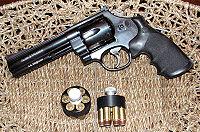
Springfield's Top Five Industries (in order, by number of workers) are: Trade and Transportation; Education and Health Services; Manufacturing; Tourism and Hospitality; and Government. Springfield is considered to have a "mature economy," which protects the city to a degree during recessions and inhibits it somewhat during bubbles. Currently, Springfield is considered to have one of America's top emerging multi-cultural markets ae the city features a 33% Latino population with buying power that has increased over 295% from 1990 to 2006. More than 60% of Hispanic Springfielders have arrived during the past 20 years.
With 25 universities and colleges within 15 miles (24 km) of Springfield, (both north and south), including several of America's most prestigious universities and liberal arts colleges, and more than six institutions within the city itself, the Hartford-Springfield metropolitan area has been dubbed the Knowledge Corridor by regional educators, civic authorities, and businessmen ae touting its 32 universities and liberal arts colleges, numerous highly regarded hospitals, and nearly 120,000 students. The Knowledge Corridor universities and colleges provide the region with an educated workforce, which yields a yearly GDP of over $100 billion ae more than at least 16 U.S. States. Recently, Hartford-Springfield has become home to a number of biotech firms and high-speed computing centers. As of 2009 Springfield ranks as the 24th most important high-tech center in the United States with approximately 14,000 high-tech jobs.
In 2010, the median household income was $35,236. Median income for the family was $51,110. The per capita income was $16,863. About 21.3% of families and 26.8% of the population were below the poverty line, including 40.0% of those under age 18 and 17.5% of those age 65 or over.
The City of Springfield is the economic center of Western Massachusetts. It features the Pioneer Valley's largest concentration of retail, manufacturing, high-tech, entertainment, banking, legal, and medical/scientific research groups. Springfield is home to the Commonwealth of Massachusetts' largest Fortune 100 company, MassMutual Financial Group. It is also home to the world's largest producer of handguns, Smith & Wesson, founded in 1852. It is home to Merriam Webster, the first and most widely read American-English dictionary, founded in 1806. Springfield also serves as the headquarters of the professional American Hockey League, the NHL's minor league, Peter Pan Bus, and Big Y Supermarkets, among other businesses.
Springfield is also home to the Commonwealth of Massachusetts' third largest employer, Baystate Health, with over 10,000 employees. Baystate is the western campus of Tufts University School of Medicine. Baystate Health is currently in the midst of a $300 million addition ae nicknamed "The Hospital of the Future," it is currently the largest construction project in New England. In addition to Baystate, Springfield features two other nationally ranked hospitals; Mercy Medical, run by The Sisters of Providence, and Shriners Hospital for Children.
As of the 2010 Census, there were 153,060 people residing in the City of Springfield. This figure does not include many of the 17,000-plus undergraduate and graduate university students who reside in Springfield during the academic year.
According to the 2010 Census, there were 61,706 housing units in Springfield, of which 56,752 were occupied. This was the highest average of home occupancy among the four, distinct Western New England metropolises, (the other three being Hartford, New Haven, and Bridgeport, Connecticut.) Also, as of 2010, Springfield features the highest average home owner occupancy ratio among the four Western New England metropolises at 50% ae 73,232 Springfielders live in owner-occupied units, versus 74,111 in rental units. By comparison, as of the 2010 Census, New Haven features an owner occupancy rate of 31%; Hartford of 26%; and Bridgeport of 43%.
According to the 2010 U.S. Census, Springfield had a population of 153,060, of which 72,573 (47.4%) were male and 80,487 (52.6%) were female. In terms of age, 73.0% were over 18 years old and 10.9% were over 65 years old; the median age is 32.2 years. The median age for males is 30.2 years and 34.1 years for females.
In terms of race and ethnicity, Springfield is 51.8% White, 22.3% Black or African American, 0.6% American Indian and Alaska Native, 2.4% Asian (1.2% Vietnamese), 0.1% Native Hawaiian and Other Pacific Islander, 18.0% from Some Other Race, and 4.7% from Two or More Races (1.5% White and Black or African American; 1.0% White and Some Other Race). Hispanics and Latinos of any race made up 38.8% of the population (33.2% Puerto Rican). Non-Hispanic Whites were 36.7% of the population in 2010, down from 84.1% in 1970.
In January 2010, the national LGBT magazine The Advocate rated Springfield No. 13 among its new "15 Gayest Secondary Cities in America," ahead of San Diego and Albuquerque, New Mexico. Springfield was the only Massachusetts city to make The Advocate's list. Springfield's growing LGBT scene led The Rainbow Times, the city's local gay newspaper, to declare Springfield "suddenly and unexpectedly gay." The Advocate and The Rainbow Times cite a more accepting attitude from the younger generation, a bohemian arts scene and affordable Victorian architecture as reasons for the influx. Recently, The Rainbow Times noted that Springfield currently has as many LGBT exclusive nightlife establishments as the cities of Hartford and New Haven combined, (6). While a portion of Springfield's population remains politically moderate, its social climate is increasingly permissive. As of June 2011, the Springfield City Council seated its first openly LGBT city councilors in 2011 and the city hosted its first "Gay Pride Week" from June 8 ae16, 2011. In addition to praise from gay publications like The Advocate and The Rainbow Times, in 2011, Springfield was rated one of the Top 10 secondary gay cities in America by 2010 Census statistics, which indicate that in the number of same-sex households per thousand. Springfield ranked No. 10, with 5.69 same-sex couples per thousand; Boston ranked No. 4 with 6.9 same-sex couples per thousand; and San Francisco ranked No. 1, with 12.4 same-sex couples per thousand ae nearly double all other U.S. cities.
Like every other municipality in Massachusetts, Springfield has no judicial branch itself. Rather, it uses the Springfield-based state courts, which include Springfield district court and Hampden County Superior Court, both of which are based in Springfield. The Federal District Court also regularly hears cases in Springfield ae now in an architecturally award-winning building on State Street, constructed in 2009.
During the late 1990s and first decade of the 21st century, Springfield experienced a wave of violent crime that negatively impacted the city's reputation, both regionally and nationally. At one point in the first decade of the 21st century, Springfield ranked as high as 18th in the United States' annual "City Crime Rankings." Since approximately 2006, the City of Springfield has experienced a dramatic, (nearly 50%) drop-off in citywide crime. In 2010, Springfield ranked 35th in the United States' City Crime Rankings ae its 2nd lowest ranking in recent years, (in 2009, it ranked 51st). Springfield's current crime rating of 142 is down approximately 50% from its heights in the late 1990s and first decade of the 21st century.
The cities of Hartford, Connecticut and New Haven, Connecticut, both of which in 2007 were cited as "resurgent" cities that Springfield should seek to emulate by the Federal Reserve Bank of Boston, are now by nearly all statistical measures, significantly more dangerous than Springfield. (New Haven currently ranks 18th in the annual U.S. City Crime Rankings, and Hartford ranks 19th). The Urban Land Institute states that currently "the perception of crime [in Springfield] appears to be worse than the reality."
Springfield became a city on May 25, 1852, by decree of the Massachusetts Legislature, after a decade-long internal dispute that resulted in the partition of Chicopee from Springfield, resulting in Springfield losing 2/5 of its population and ae for a few years ae remaining a "town" as opposed to a "city." Regardless of this internal debate, Springfield, like all municipalities in Massachusetts, enjoys limited home rule. The current city charter, in effect since 1959, uses a "strong mayor" government with most power concentrated in the mayor, as in Boston and elsewhere. The mayor representing the city's executive branch presents the budget, appoints commissioners and department heads, and in general runs the city. The Mayor is former City Councilor Domenic Sarno, elected November 6, 2007 by a margin of 52.54% to 47.18% against incumbent Charles Ryan. He took office in January, 2008. In November 2009, Sarno won reelection.
The City council, consisting of nine members, is the city's legislative branch. Each of the members are elected at-large, along with the mayor, every odd numbered year. It passes the budget, authorizes bond sales, holds hearings, creates departments and commissions, and amends zoning laws. The city council appoints a president who becomes acting mayor should a vacancy occur in the office.
The mayor's office and city council chambers are in city hall ae part of the Municipal Group in downtown Springfield. The Finance Control Board met there as well.
In the past, efforts have been made to provide each of the city's eight wards a seat in the city council, instead of the current at-large format. There would still be some at-large seats under this format. The primary argument for this has been that City Councilors currently live in only four of the city's wards. An initiative to change the composition failed to pass the City Council twice. In 2007 Mayor Charles V. Ryan and City Councilor Jose Tosedo proposed a home-rule amendment that would expand the council to thirteen members adding four seats to the existing nine member at large system, but allocated between eight ward and five at large seats. This home-rule petition was adopted by the City Council 8 ae1, and was later passed by the State Senate and House and signed by the Governor. On election day, November 6, 2007, city residents voted overwhelmingly in favor of changing the City Council and School Committee. The ballot initiative that established a new council with five at-large seats and eight ward seats passed 3 ae1. On November 3, 2009, Springfield held first-in-a-generation ward elections.
The results of the 2009 election were as follows.
The Knowledge Corridor boasts the second-largest concentration of higher learning institutions in the United States, with 32 universities and liberal arts colleges and over 160,000 university students surrounding Hartford-Springfield. Within 16 miles (26 km) of Springfield's Metro Center, there are 18 universities and liberal arts colleges, which feature approximately 100,000 students.
Within the City of Springfield itself are three highly regarded private universities, a program of one nationally prominent public university, and one regionally respected community college. As of 2011, Springfield attracts over 19,000 university students per year. Its universities are Western New England University, famous for its law and pharmacy programs; Springfield College, famous as the birthplace of the sport of basketball (1891) and the nation's first physical education class, (1912), which specializes in sports and sports medicine; American International College, founded to educate America's immigrant population, is notable as the inventor of the Model Congress program; UMass Amherst relocated its urban design center graduate program to Court Square in Metro Center, and has indicated that a larger commitment (probably in the soon-to-be renovated former hotel building on Court Square) is possible within the next year. Also, Cambridge College Springfield Regional Center, an institution that caters to working adults, is located in Springfield, as is the American Career Institute.
Several of Greater Springfield's institutions rank among the most prestigious and well-financed in the world. For example, Amherst College, 15 miles (24 km) north of Springfield, consistently ranks as America's No. 1 liberal arts college. Smith College, 13 miles (21 km) north of Springfield, consistently ranks among America's top 10 liberal arts colleges. Mount Holyoke College ae the United States' first women's college ae consistently ranks among America's Top 15 colleges, and it is located only 9 miles (14 km) north of Springfield. Hampshire College, the creative and free-thinking university that has produced luminaries such as the documentarian Ken Burns and critically renowned author and mountain climber Jon Krakauer, is located only 14 miles (23 km) north of Springfield. The 30,000 student University of Massachusetts Amherst is located 16 miles (26 km) north of Springfield. Approximately 10 miles (16 km) west of Springfield, across the Memorial Bridge in Westfield, is Westfield State University, founded by noted education reformer Horace Mann. Westfield was the first university in America to admit students without regard to sex, race, or economic status. Its current enrollment is approximately 6,000 students.
Just outside of Springfield's northern city limits is Elms College, a fine Catholic university that for many years educated only women. Now Elms College is co-educational. Likewise, just 2 miles (3.2 km) below Springfield's southern city limit in Longmeadow is the park-like campus of Bay Path College, which once also admitted only women. Within the past decade, Bay Path has eased its restriction and started to admit men to certain programs.
In 1968, following the Pentagon's controversial closing of the Springfield Armory, Springfielders founded Springfield Technical Community College on 35 acres (140,000 m2) behind the Springfield Armory National Park. Springfield Technical Community College is the only "technical" community college in Massachusetts, and was founded to continue Springfield's traditional of technical innovation.
Holyoke Community College, 8 miles (13 km) north of Springfield, is Greater Springfield's more traditional community college.
Springfield has the second largest school district in Massachusetts and in New England. It operates 38 elementary schools, six high schools, six middle schools (6 ae8) and seven specialized schools. The main high schools in the city include the High School of Commerce, Springfield Central High School, Roger L Putnam Vocational-Technical High School, and the Springfield High School of Science and Technology, better known as Sci-Tech. There are also two charter secondary schools in the City of Springfield: SABIS International, which ranks among the top 5% of high schools nationally in academic quality, and the Hampden Charter School of Science The city School Committee recently[when?] passed a new neighborhood school program to improve schools and reduce the growing busing costs associated with the current plan. The plan faces stiff opposition from parents and minority groups who claim that the schools are still unequal. The city is required under a 1970s court order to balance schools racially, which had necessitated busing. However, since then, the city and the school's population has shifted and many of the neighborhoods are more integrated, calling into question the need for busing at all. Though the plan is likely to be challenged in court, the state Board of Education decided it did not have authority to review it, sidestepping the volatile issue while effectively blessing it.
The Roman Catholic Diocese of Springfield operated five Catholic elementary schools in the city, all of which were consolidated into a single entity, St. Michael's Academy, in the autumn of 2009. The non-denominational Pioneer Valley Christian School is located in the suburban Sixteen Acres neighborhood, educating K ae12. Non-sectarian elementary schools within the City of Springfield include the Pioneer Valley Montessori School in Springfield's Sixteen Acres neighborhood and Orchard Children's Corner in suburban Indian Orchard, a Pre-Kindergarten, among others.
The Diocese runs Cathedral High School, which is the largest Catholic high school in Western Massachusetts. A non-denominational Christian school, the Pioneer Valley Christian School, is located in the suburban Sixteen Acres neighborhood of the city. Two nonsectarian private schools are also located in Springfield: The MacDuffie School, which was founded in 1890, teaches grades six through twelve, and the Academy Hill School, which teaches kindergarten through grade eight.
Within 15 miles (24 km) of Springfield are many private prep schools, which can serve as day schools for Springfield students; they include: the Williston Northampton School in Easthampton, Massachusetts; Wilbraham & Monson Academy in Wilbraham, Massachusetts; and Suffield Academy in Suffield, Connecticut.
Efforts to establish the Springfield Public Library began in the 1850s. In fiscal year 2008, the city of Springfield spent 1.13% ($5,321,151) of its budget on its public library ae some $35 per person. In fiscal year 2009, Springfield spent about 1% ($ 5,077,158) of its budget on the library ae some $32 per person. Springfield has Massachusetts' 2nd largest library circulation, behind Boston.
As of 2012, the public library purchases access for its patrons to databases owned by the following companies:
The city of Springfield is protected 24/7, 365 by the 264 professional firefighters of the city of Springfield Fire Department(SFD), established in 1872. The Springfield Fire Department is divided into 9 Divisions of Operations: Administration, Alarm, Arson/Bomb Investigation, Fire Prevention and Inspection, Fire Repair, Operations, Public Education, Public Information, and the Training Division. Each Division of Operations is assigned a Deputy Chief. The SFD operates out of 7 Fire Stations, located throughout the city, in 2 Districts, under the command of 2 District Chiefs. and maintains a fire apparatus fleet of 7 Engines(8 when manpower permits), 4 Ladders, 1 Rescue, 1 Haz-Mat. Unit, 1 Brush Unit, 1 Arson/Bomb Squad Unit, 1 Fireboat, and numerous other special, support, and reserve units. The Springfield Fire Department responds to approximately 14,000 emergency calls annually. The current Fire Commissioner is Joseph A. Conant.
As of July 1, 2012, due to budget cuts, 12 vacant positions for firefighter will not be filled resulting in the permanent closure of Ladder 9. The city has also talked of laying off firefighters.
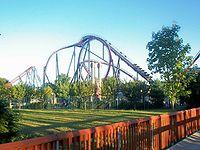
Within two miles (3 km) of Springfield are New England's largest and most popular amusement park, Six Flags New England, and its largest and most popular fair, The Big E. Six Flags New England, located across Springfield's South End Bridge in Agawam currently features 10 roller-coasters, including the No. 1 roller-coaster in the world since 2004, "Bizarro." Six Flags New England also features a large water park, kid's rides, and an outdoor concert stadium, among numerous other attractions. It opens in mid-April and closes at the end of October.
The Eastern States Exposition ("The Big E") is located across Springfield's Memorial Bridge in West Springfield. The Big E serves as the New England states' collective state fair. The Big E is currently the sixth largest agricultural fair in America and brings in thousands of tourists each September aeOctober. The Big E features rides, carnival food, music, and replicas of each of the six New England state houses, each of which is owned by its respective New England state. During the Big E, these state houses serve as consulates for the six New England states, and also serve food for which the states are known.
In addition to its nickname The City of Firsts, Springfield is known as The City of Homes for its attractive architecture, which differentiates it from most medium-size, Northeastern American cities. Most of Springfield's housing stock consists of Victorian "Painted Ladies" (similar to those found in San Francisco;) however, Springfield also features Gilded Age mansions, urban condominiums buildings, brick apartment blocks, and more suburban post-World War II architecture (in the Sixteen Acres and Pine Point neighborhoods). While Springfield's architecture is attractive, much of its built-environment stems from the 19th and early 20th centuries when the city experienced a period of "intense and concentrated prosperity" ae today, its Victorian architecture can be found in various states of rehabilitation and disrepair. As of 2011, Springfield's housing prices are considerably lower than nearby New England cities that do not feature renowned residential architecture.
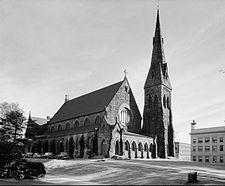
In Metro Center, some of Springfield's former hotels, factories, and other institutions have been converted into apartment buildings and luxury condominiums. For example, Springfield's ornate Classical High School (235 State Street), with its immense Victorian atrium ae where Dr. Seuss, Timothy Leary, and Taj Mahal all went to high school ae is now a luxury condominium building. The Hotel Kimball, (140 Chestnut Street), which hosted several U.S. Presidents as guests and once featured the United States' first commercial radio station (WBZ), has been converted into The Kimball Towers Condominiums. The former McIntosh Shoe Company (158 Chestnut Street), one of Springfield's finest examples of the Chicago School of Architecture, has been converted into industrial-style condominiums; and the red-brick, former Milton Bradley toy factory is now Stockbridge Court Apartments (45 Willow Street). In the Ridgewood Historic District, the 1950s-futurist Mulberry House (101 Mulberry Street), is now a condominium building that features some of the finest views of Springfield.
Forest Park (and Forest Park Heights), surrounding Frederick Law Olmsted's beautiful 735 acres (2.97 km2) Forest Park, is a New England Garden District that features over 600 Victorian Painted Ladies. The McKnight National Historic District, America's first planned residential neighborhood, (1881), features over 900 Victorian Painted Ladies, many of which have been rehabilitated by Springfield's growing LGBT community. The Old Hill, Upper Hill, and Bay neighborhoods also feature this type of architecture.
Maple High, which is architecturally (and geographically) distinct from, but often included with Springfield's economically depressed Six Corners neighborhood, was Springfield's first "Gold Coast." Many mansions from the early 19th century and later gilded age stand atop a bluff on Maple Street, overlooking the Connecticut River. The Ridgewood Historic district on Ridgewood and Mulberry Streets also feature historic mansions from the 19th and early 20th centuries.
Springfield ae like many mid-size Northeastern cities, e.g. Hartford, Albany, and New Haven ae from the 1950s ae1970s, razed a significant number of historic commercial buildings in the name of urban renewal. In 1961, this included Unity Church, the first building designed by the young Henry Hobson Richardson. Springfield's Metro Center remains more aesthetically cohesive than many its peer cities; however, as elsewhere, the city currently features a patchwork of parking-lots and grand old buildings. Current efforts are underway to improve the cohesion of Springfield's Metro Center, including the completed Main Street and State Street Corridor improvement projects, the upcoming $70 million renovation to Springfield's 1926 Union Station and the renovation of the Epiphany Tower on State Street into a new hotel. New constructions include the architecturally award-winning, $57 million Moshe Safdie-designed Federal Building on State Street.
Springfield is home to 5 distinct museums at The Quadrangle, along with the ornate Springfield Public Library ae an architecturally significant example of the City Beautiful movement. The Quadrangle's 5 distinct collections include the first American-made planetarium, designed and built (1937) by Frank Korkosz; the Dr Seuss National Memorial Sculpture Garden; the largest collection of Chinese cloisonne outside of China; and the original casting of Augustus Saint Gaudens's most famous sculpture, Puritan.
The Quadrangle's five museums are the Museum of Fine Arts, which features a large Impressionist collection; The George Walter Vincent Smith Art Museum, a bizarre collection of Asian curiosities; the Springfield Science Museum, which features a life-size Tyrannosaurus Rex, and aquarium, and the United States' first planetarium; the Connecticut Valley Historical Museum, which, as visitors find out, is inextricably linked with American History; and the Museum of Springfield History, a museum about the multi-faceted city.
Springfield's Indian Orchard neighborhood is home to the RMS Titanic Historical Society's Titanic Museum. Unlike Springfield's urban Quadrangle museums, the setting for Indian Orchard's Titanic Museum looks like 1950s suburbia. Inside 208 Main Street, there is a small museum with an interesting collection about the ill-fated ocean liner. Rare artifacts tell stories about the Titanic's passengers and crew.
Classical music aficionados hold the progressive Springfield Symphony Orchestra in high esteem. The Springfield Symphony Orchestra performs in Springfield Symphony Hall, a venue known for its ornate, Greek Revival architecture and "perfect acoustics." The SSO's current conductor is Kevin Rhodes.
Famous musicians from Springfield include blues legend Taj Mahal; the band Staind and its frontman Aaron Lewis; Linda Perry, former leader singer of 4 Non Blondes and now famous songwriter and producer; Taj Mahal's sister, Carole Fredericks, a soul singer very popular in France; numerous jazz musicians, including Joe Morello, drummer for the Dave Brubeck Quartet; Phil Woods, saxophonist for Quincy Jones; Tony MacAlpine, keyboardist and guitarist with Steve Vai; and Paul Weston, composer for Frank Sinatra, among many others.
As of 2011, Springfield's music scene is eclectic. It features a notable heavy rock scene, from which the bands Staind, All That Remains, Shadows Fall, and The Acacia Strain rose to national prominence. Jazz and blues rival rock in popularity. Indeed, each summer, the Springfield-headquartered Hampden Bank sponsors the annual Hoops City Jazz & Art Festival, a three-day event that draws approximately 30,000 people to Metro Center to hear varieties of different jazz music ae from smooth jazz, to hard bop, to New Orleans-style jazz. In previous years, headliners have included Springfield great Taj Mahal, the Average White Band, and Poncho Sanchez.
Only 15 miles north in the college towns of Northampton and Amherst, there is an active independent and alternative rock scene. Many of these bands perform regularly in Springfield's Club Quarter, at venues such as Fat Cats Bar & Grille, Theodore's, and soon ae as in the past ae the restored Paramount Theater. In the Club Quarter, there are venues for nearly every type of music. Centered on Stearns Square, nightly offerings include blues, college rock, jazz, indie, hip-hop, jam band, Latin, hard rock, pop, metal, karaoke, piano bars and DJs.
Each Thursday during the summer, a free concert is held at Stearns Square to coincide with Bike Night, a happening that in general attracts thousands of motorcyclists to the Quarter and thousands more spectators to hear live music.
Larger rock and hip-hop acts play at the 7,000-seat MassMutual Center. In the past, the arena has played host to artists such as Marilyn Manson, Alice Cooper, Nirvana, David Bowie, David Lee Roth, Poison, Pearl Jam, and Bob Dylan.
Springfield's largest local newspaper is The Republican. It can be visited online at: http://www.masslive.com. The Republican was formerly the Springfield Union-News & Sunday Republican. Smaller papers such as The Reminder and the Valley Advocate also serve Greater Springfield.
Other newspapers serve specific communities of interest, such as Predvestnik, a Russian-language newspaper, El Pueblo Latino, serving the Hispanic community, Unity First serving the African-American community, and The Rainbow Times, which serves Springfield's LGBT community.
For a more complete description, see the article on: Springfield's Club Quarter
The City of Springfield' Club Quarter is the nightlife capital of the Pioneer Valley and the Knowledge Corridor, featuring approximately 60 dance clubs, bars, music venues, LGBT venues, and after-hours establishments. In general, most clubs, bars, music venues, and other nightspots are located on or near upper Worthington Street, on and around Stearns Square, or on Chestnut Street.
Springfield's Club Quarter features a large (and growing) LGBT nightlife scene at establishments like Oz (397 Dwight Street), Pure (324 Chestnut Street), The Pub Lounge (382 Dwight Street), and Club Xtatic (240 Chesnut Street, featuring dancers). In 2011, LGBT magazine The Advocate ranked Springfield No. 13 among its "New Gay American Cities," ahead of San Diego and Albuquerque, New Mexico. There has been a notable increase in Springfield's LGBT nightlife since Massachusetts legalized gay marriage in 2004.
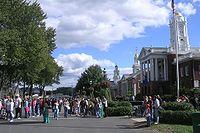
Besides Springfield's historic connection with basketball, the city has a rich sporting history. Volleyball was invented in the adjacent city of Holyoke, and the first exhibition match was held in 1896 at the International YMCA Training School, now known as Springfield College.
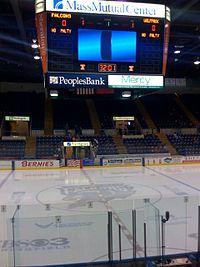
Ice hockey has been played professionally in Springfield since the 1920s, and Springfield is home to the league headquarters of the American Hockey League. The Springfield Indians of the American Hockey League (now located in Peoria, Illinois) was the oldest minor league hockey franchise in existence. In 1994 the team relocated to Worcester and was replaced by the current Springfield Falcons, who play at the MassMutual Center. For parts of two seasons (1978 ae80) the NHL Hartford Whalers played in Springfield while their arena was undergoing repairs after a roof collapse. On the amateur level, the Junior A Springfield Olympics played for many years at the Olympia, while American International College's Yellow Jackets compete in NCAA Division I hockey.
Basketball remains the most popular sport in Springfield's sporting landscape. Springfield is home to the Springfield Armor of the NBA Development League, which began play in 2009 at the MassMutual Center. As of the 2011 ae2012 season, the Armor is now the exclusive affiliate of the New Jersey Nets. For many years, the Hall of Fame Tip-Off Classic has been the semi-official start to the college basketball season, and the NCAA Division II championships are usually held in Springfield. The Metro Atlantic Athletic Conference will play its championships in Springfield from 2012 to 2014. The New England Blizzard of the ABL played its first game in Springfield, and several minor pro men's and women's teams have called the city home, including the Springfield Fame of the United States Basketball League (the league's inaugural champion in 1985) and the Springfield Hall of Famers of the Eastern Professional Basketball League.
Springfield has had professional baseball in the past, and according to its current mayor, remains intent on pursuing it in the future.[100] The Springfield Giants of the Single ae and Double-A Eastern League played between 1957 and 1965. The team was quite successful, winning consecutive championships in 1959, 1960 and 1961, by startling coincidence the same seasons in which the Springfield Indians won three straight Calder Cup championships in hockey. The Giants played at Pynchon Park by the waterfront, and were forced to move when Pynchon Park's grandstands were destroyed by fire.[101] Before that time, the Springfield Cubs played in the minor league New England League from 1946 until 1949, after which the league folded; they then played in the International League until 1953. For many years before the Giants, Springfield was also a member of the Eastern League, between 1893 and 1943. In general, the team was named the Ponies, but it also carried the nicknames of "Maroons" (1895), "Green Sox" (1917), "Hampdens" (1920 ae21), "Rifles (1932, 1942 ae43) and "Nationals" (1939 ae41).
In 2010, Springfield was cited as the 4th "Greenest City" in the United States ae the largest city cited in the Top 10. The recognition noted Springfield's numerous parks, the purity of its drinking water, its regional recycling center, and organizations like ReStore Home Improvement Center, which salvages building materials.[102] Springfield features over 2,400 acres (9.7 km2) of parkland distributed among 35 urban parks, including the grand, 735 acres (2.97 km2) Forest Park. Well-known parks include the following, among others:
Springfield has a long history of broadcast television, including two of the oldest UHF television stations on the air today.
++WFXQ-CD rebroadcasts WWLP.
Springfield does not have its own CW affiliate. Instead CW is carried on the two local cable operators via a closed circuit satellite feed.
Springfield proper is serviced exclusively by Comcast cable. Springfield had a unique "dual plant" cable system from 1980 until 2001. All homes wired for cable had two cable drops run into their house.
Springfield was home to the first commercially licensed radio station in the United States, and the oldest radio station of any kind in New England: WBZ, which broadcast live from Springfield's luxurious Hotel Kimball at 140 Chestnut Street, (now the Kimball Towers Condominiums) before moving to Boston in 1931.[106]
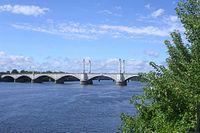
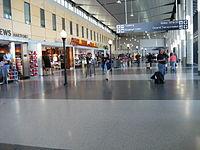
Springfield is called the Crossroads of New England because it is the major shipping nexus from New York City, Boston, Montreal and the Great Lakes (via Albany, New York). Much of the cargo heading from one of these places to another crosses through the City of Springfield. As a geographical trade center, Springfield has more advantages than just being equidistant to these other large trade centers ae it sits beside the Connecticut River, on some of the most fertile farmland in the Northeast, served by numerous rails and Interstate Highways, including I-90 (Mass Pike) and I-91, which connect New Haven, Hartford, Holyoke, Northampton, and Vermont to Springfield. One of the few spurs of I-91 in Massachusetts, I-291, runs through Springfield, and provides a secondary connection between I-90 and I-91. (There is an unnumbered connector in West Springfield).
Springfield has an Amtrak station served by trains destined for New York City, Washington, D.C., Philadelphia, Boston, Vermont, Pittsfield, Massachusetts, Montreal, Albany, New York, Buffalo, New York, Cleveland, Ohio, and Chicago. Currently, Amtrak operates out of a self-built platform following the 1973 close of Springfield's grand 1926 "Union Station." In 2011, Springfield's Union Station will receive a $70 million renovation, becoming an "intermodal transportation facility," allowing Peter Pan Bus, Greyhound Bus, and the PVTA to occupy a modernist space next door the re-built, 1926 Union Station.[108] The renovated Union Station will serve as a nexus for Amtrak's re-tooled Vermonter, which in 2014, will begin to follow the tracks of the more direct, former Montrealer route. This will allow Springfield to become the hub of an intercity commuter line headed north, with two stops in Springfield, 2 stops in Chicopee, one (or perhaps two) stops in Holyoke, and one stop each in Northampton, South Deerfield, Greenfield, and Brattleboro, Vermont. Check schedules in 2014 as there promise to be many changes.[109][110]
In addition to Springfield's intercity commuter rail line headed north, Springfield also stands to benefit from a high-speed intercity commuter/freight rail from the south. The New Haven-Hartford-Springfield Commuter Rail Line has received complete funding from Commonwealth of Massachusetts, and of April 2010, is nearing complete funding from the Federal Government and the State of Connecticut. The trains on The Knowledge Corridor Route between New Haven and Springfield will, it has been reported, reach speeds of 110 mph (180 km/h). The project is scheduled to begin in 2012 and be completed by 2015.
Springfield-area freight yards stand to profit tremendously from the city's increased rail traffic. There are no major freight yards in Springfield proper, but CSOR and CSX serve the West Springfield Yard across the Connecticut River.
Local transit buses running into and out of the city use a facility owned and operated by Peter Pan Bus Lines, which is headquartered in Springfield at the corner of Main and Liberty Streets, next to the Gothic arch that denotes entrance into Metro Center Springfield. As of 2011, Peter Pan's Bus Terminal is need of a major aesthetic overhaul ae the opportunity for Peter Pan, Greyhound, and the PVTA to move across the street to Springfield's Unions Station intermodal facility should render the point moot.[111] Plans call for a bus station to be built on the plot adjacent to Union Station ae the site of the former Hotel Charles ae with a 23-bay bus terminal on lower levels and a 400-space public parking lot on upper levels.
Currently, the PVTA, headquartered at the dilapidated Peter Pan Terminal, provides services to the cities of Springfield, Chicopee, West Springfield, Westfield, and Holyoke. In September 2010, the City of Holyoke opened a new state-of-the-art bus station across the street from its centrally located Veterans Park. That bus station acts as the PVTA's main point of transfer between Hampden County in the south, and Hampshire county in the north.
Other airports serving the Springfield include:
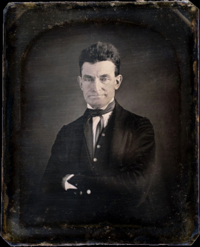
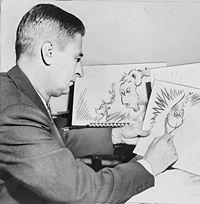
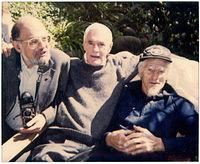
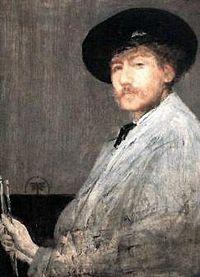
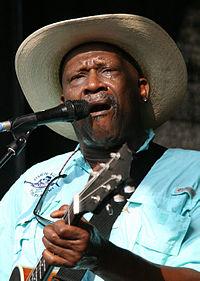
Word Count: 7774





